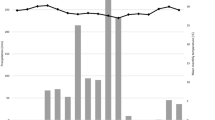Abstract
Loblolly pine (Pinus taeda L.) silvopastures often are established and maintained on sites of poor soil fertility and minimal fertilizer input. Our objective was to determine whether row spacing affected yield, quality, and botanical composition of minimally managed herbage in loblolly pine early in the tree rotation. Plots were randomly located equidistant from bordering tree rows in each of eight alley width treatments that were 2.4, 3.6, 4.9, 7.3, 9.7, 12.2, 14.6 m wide, and no trees. Row spacing affected the yield, quality, and botanical composition of pasture five to six years in the rotation especially at densities exceeding 840 trees ha−1. Botanical composition shifted from predominantly cool-season to warm-season grasses between annual first- and second-harvests, respectively, which caused seasonal differences in several yield and quality traits. Tall fescue (Festuca arundinacea Schreb.) production appeared to be unsustainable under minimal management. Herbage yield generally increased, but quality and minerals (crude protein, IVDMD, Ca, and P) tended to decrease with spacing. The 4.9 m row spacing was minimally acceptable for herbage yield and quality. System design should seek to balance tree-crop yield and quality within the context of management constraints and site productivity.
Similar content being viewed by others
References
Belesky D.P., Fedders J.M., Ruckle J.M. and Turner K.E. 2002. Bermudagrass - white clover - bluegrass sward production and botanical dynamics. Agron J 94: 575–584.
Brockway D.G., Wolters G.L., Pearson H.A., Thill R.E., Baldwin V.C. and Martin A. 1998. Understory plant response to site preparation and fertilization of loblolly and shortleaf pine forests. J Range Manage 51: 47–54.
Clason T.R. 1999. Silvopastoral practices sustain timber and forage production in commercial loblolly pine plantations of northwest Louisiana, USA. Agrofor Syst 44: 293–303.
Clason T.R. and Sharrow S.H. 2000. Silvopastoral practices. In: Garrett H.E. and et al. (eds), North American Agroforestry. Am Soc Agron, Madison, WI, pp. 119–147.
Cruz P., Sierra J., Wilson J.R., Dulormne M. and Tournebize R. 1999. Effects of shade on the growth and mineral nutrition of tropical grasses in silvopastoral systems. Ann Arid Zone 38: 335–361.
Halls L.K. 1955. Grass production under dense longleaf-slash pine canopies. RN-SE-83. USDA/FS, Asheville, NC, USA.
Haynes R.W. 1990. An analysis of the timber situation in the United States: 1989- 2040. Gen Tech Rep RM-199. USDA/FS, Fort Collins, CO, USA.
Jose S., Gillespie A.R., Seifert J.R. and Biehle D.J. 2000. Defining competition vectors in a temperate alley crop** system in midwestern USA. 2. Competition for water. Agrofor Syst 48: 41–59.
Knowles R.L., Horvath G.C., Carter M.A. and Hawke M.F. 1999. Develo** a canopy closure model to predict overstorey/understorey relationships in Pinus radiata silvopastoral systems. Agrofor Syst 43: 109–119.
Lin C.H., McGraw R.L., George M.F. and Garrett H.E. 1999. Shade effects on forage crops with potential in temperate agroforestry practices. Agrofor Syst 44: 109–119.
McEwen L.C. and Dietz D.R. 1965. Shade effects on chemical composition of herbage in the Black Hills. J Range Manage 18: 184–190.
Morris D.R. and Clason T.R. 1997. Summer forage production under loblolly pine stands. Commun Soil Sci Plant Anal 28: 717–726.
National Research Council (NRC) 1996. Nutrient Requirements of Beef Cattle. 7th edn. Nat'l Acad Press, Washington, DC.
Pearson H.A., Knowles R.L., Middlemiss P.G., Baldwin V.C. and Busby R.L. 1995a. United States agroforestry estate model. Compiler 13: 27–37.
Pearson H.A., Wolters G.L., Thill R.E., Martin A. Jr. and Baldwin V.C. 1995b. Plant response to soils, site preparation, and initial pine planting density. J Range Manage 48: 511–516.
Pfister J.A. 2000. Food aversion learning to eliminate cattle consumption of pine needles. J Range Manage 53: 655–659.
Robinson J.L. and Clason L. 2000. From a pasture to a silvopasture system. US Dept Agric, Nat'l Agrofor Cntr, AF Note 22, Dec, 2000.
SAS Institute 1998. SAS/STAT User's Guide. 7.00th edn. SAS Inst, Cary, NC, Windows version 4.10.1998.
Schultz R.P. 1997. Loblolly Pine. US Dept Agric, For Serv Agric Hndbk 713. US Govt Print Off, Washington, DC.
Steel R.G.D. and Torrie J.H. 1980. Principles and Procedures of Statistics: A Biometrical Approach. McGraw-Hill, New York.
Struik P.C. 1983. The effects of short and long shading, applied during different stages of growth, on the development, productivity and quality of forage maize (Zea mays L.). Neth J Agric Sci 31: 101–124.
US Dept. of Agriculture, Econ. Res. Serv., hau http://www.ers.usda.gov/data/costsandreturns/, updated 9 March 2001
Wolters G.L. 1973. Southern pine overstories influence herbage quality. J Range Manage 26: 423–426.
Author information
Authors and Affiliations
Corresponding author
Rights and permissions
About this article
Cite this article
Burner, D., Brauer, D. Herbage response to spacing of loblolly pine trees in a minimal management silvopasture in southeastern USA. Agroforestry Systems 57, 69–77 (2003). https://doi.org/10.1023/A:1022943224478
Issue Date:
DOI: https://doi.org/10.1023/A:1022943224478




